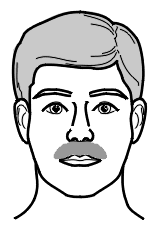German Reenactor's Appearance
![]() What did a German Soldier look like? We already know something about his uniform, equipment, etc. But what did the actual person inside the uniform look like?
What did a German Soldier look like? We already know something about his uniform, equipment, etc. But what did the actual person inside the uniform look like?
Facial Hair--Facial hair was worn in the German armed forces, but, with specific regulations applying to all enlisted men. Mustaches could be worn, but sideburns and other exotic facial hair were not allowed. Some specifics were:
- Mustaches--Although they were not common, small mustaches were worn by some older soldiers. The correct mustache for a German reenactor (if you must have one) should be at least ¼ inch from the corners of the mouth. A more common mustache extended straight down from the nose like a brush (i.e. a “Hitler brush”). Although mustaches are discouraged, they usually are allowed within these parameters. Saying this, the ratio of clean-shaven men to mustachioed men should be about 15 to 1. Another thought on mustaches--while mustaches were permitted in the German Army, they were rarely worn, as it was simply not in style at this time. And in “elite” units, they didn’t wear mustaches. And yes, you may find a rare photo of a GD or SS man with a Schnurbart, but this is quite the exception. Please, remember that our purpose is historical accuracy, not looking “cool!” MUSTACHES are not correct!!!
|
|||
|
Preferred |
"Schickelgrüber" |
"Hollywood" |
"Pencil" style |
|
|||
|
|
"Limey," "modern police"
or "US Army" styles |
||
- Hair--Although the truly authentic haircut is shaved from the neck and tapered up to the top of the ears all the way around and slicked straight back (actually worn quite long on top). We realize that this is a little extreme, especially if we don't want to scare our families or the people we work with! [Well, okay... some of us do!!] We require that the hair be short enough on the sides as to not touch the ears (i.e. “whitewalls” with NO sideburns), and short enough in back to not touch a regular dress-shirt collar. This is very important, since many events have very strict rules on haircuts, and if you find yourself with too long hair at one of these events, the only options are to leave the event or... have the “field barber” cut your hair on the spot. If you have ever seen anyone who has been to the field barber, you will know that this truly is a more frightening prospect than it sounds. Anyway, the drawing below shows the correct “Prussian” haircut that we want to emulate.
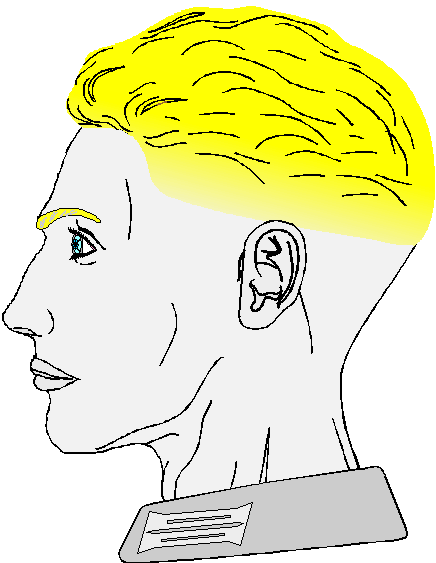
- Tattoos--Yes, the Germans had them, especially those soldiers from the port cities
(a sailor’s trademark, we suppose). If your tattoos have German words in them, good for you. If there aren’t any words in them, perhaps you’re still all right. If your tattoo says “MOM” or “USMC,” keep your shirt sleeves rolled down!

- Glasses--Non-period frames are really noticeable and detract greatly from the unit impression. Get yourself a pair of silver, round-lensed wire-rimmed frames, wear contacts, or... do without your glasses. If you are going without your prescription eye wear, make sure that your unit commander or squad leader knows. This would be for your safety as well as anyone else at the event.

- Weight--Take a look at original photographs and you will see that the men are quite thin. This is mostly due to the wartime diet and the stress of combat. When we ask veterans to criticize our impressions, the bolder ones will always say: “You are all too fat!” Be conscious of your weight--which is something we should all try and do more of anyway!

- Age--By December of 1943, more than 1,500,000 out of a total of 4,270,000 men in the German Army were over 34 years old. Many of those below 34 were very young
(17 to 19) or were recovering from wounds or frostbite. The average age in the whole Army was 31.5 years old. Compare this with the average age for a GI which was about 26 years old.
 The average age also varied from unit to unit. For example, the average age of soldiers in the 709th Division was 36. In this division, gun crew ages averaged 45, and some of the men were actually over 55. Generally though, these older men were placed in support services such as supply or medical and signals units.
The average age also varied from unit to unit. For example, the average age of soldiers in the 709th Division was 36. In this division, gun crew ages averaged 45, and some of the men were actually over 55. Generally though, these older men were placed in support services such as supply or medical and signals units.

- Posture--We once showed a picture of a bunch of German reenactors to a veteran and asked for his comments and one of the things he said was: “Look at that! He is standing like an American, slouched with hands in pockets!” Be careful of the typical casual American posture, the traditional German stance is much more upright.

- Chewing Gum--The Germans commented frequently on this--“Those Americans are always chewing, chewing, chewing, just like cows.” In fact, one slang term the Germans had for Americans was „Kaugummifresser.“ Do not chew gum when portraying a German soldier!
Updated 5.12.98
© 1998 M.L. Pariss Electronic Design Studio
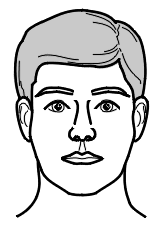
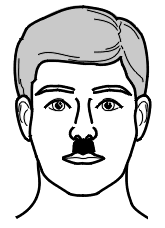
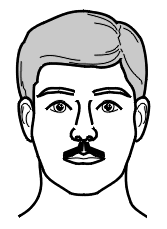
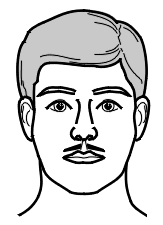
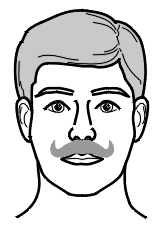 "Handlebar" style
"Handlebar" style